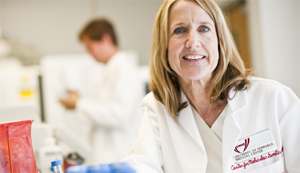Everyone knows Thomas Edison was a brilliant scientist.
Most people don’t know he was dyslexic.
Kicked out of school because he was “dumb,” the inventor of the phonograph, motion picture camera and lightbulb also struggled with words and speech.
 |
Shelley Smith, Ph.D. |
Shelley Smith, Ph.D., along with Mabel Rice, Ph.D., of the University of Kansas and Javier Gayán, Ph.D., of Neocodex in Seville, Spain, recently discovered a link between a particular gene and language impairment.
The “KIAA0319” gene on chromosome 6 had previously been associated with reading disability. The new finding shows it can affect both reading and language.
“It has been thought that reading disability, language impairment and speech disorder were entirely separate conditions, and they are usually diagnosed separately and treated separately,” Dr. Smith said. “This finding confirms that there are common factors.”
Dyslexia is the most common learning disability, language impairment is the second most common and speech disorders rank high as well.
While language involves vocabulary and grammar, and speech involves accuracy of sound production, both contribute to a child’s ability to read. The finding that a certain gene could influence all three abilities suggests a common pathway contributes to overlapping strengths or weaknesses across speech, language and reading.
|
Previous studies had not found such overlap. Reading disability genes appeared on certain chromosomes, and language impairment genes had been localized to other chromosomes.
As the genes that influence learning disabilities are defined and the cognitive overlaps between disorders worked out, genetic studies will be able to confirm which diagnoses have common genetic effects and which are distinct.
“It’s likely that the current diagnostic criteria may be modified,” Dr. Smith said. “A better definition of the three disorders should lead to optimal treatment procedures based on deficits that are closer to genetic makeup than clinical symptoms alone.”
Dr. Smith believes other genes also will be found that account for all three disorders, and hopes to do further studies to determine how the genes interact in order to better understand how the brain handles reading and language information.